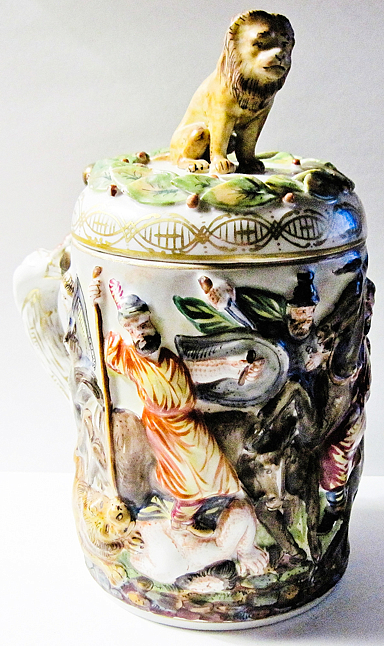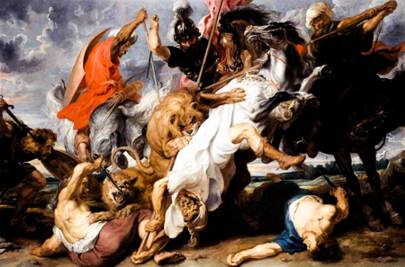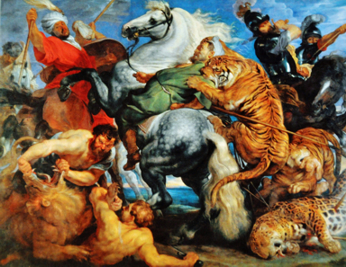
 Stein Collectors International
Stein Collectors International
Featured Stein: June 2020

 Stein Collectors International
Stein Collectors International
Featured Stein:
June 2020
 The
Truth About Capo-di-Monte's
The
Truth About Capo-di-Monte's
"The Lion Hunt Stein"
By
Steve Breuning
Peter Paul
Rubens (1577 - 1640) was Flemish artist and later a diplomat. He is
regarded as the most influential artist of what was called the Flemish
Baroque movement. Rubens was born in Siegen, Germany, and named after
Saints Peter and Paul. When he was 12, he and his mother moved to
Antwerp, Belgium. Here he received a Renaissance Humanist education and
focused on classical literature, Latin, and art. When he was 23, Rubens
traveled to Italy and studied classical Greek and Roman art. Rubens'
art was filled with nudity, drinking, orgy type scenes, "Rubenesque"
characters, and religious overtones.
One can look at
virtually any painting by Peter Paul Rubens and any Capo-di-Monte stein
and see that his art had a pronounced effect on the decorations on the
steins. For example, SCI’s July, 2019 Featured Stein is an 18th century
Capo-di-Monte stein presented by Randy Satterfield. It is described as
having a wrap-around relief of what appears to be an orgy scene
(nudity, drinking) followed by a hunt scene. This is clearly
reminiscent of Rubens art.
In 1615-1616,
Rubens was commissioned by Maximilian I, Elector of Bavaria, to create
a series of hunting paintings to decorate the Schleißheim Palace. These
were: The Wild Boar Hunt, The Wolf and Fox Hunt, The Lion Hunt, The
Hippopotamus and Crocodile Hunt, and The Tiger Hunt.
Two of the paintings in Rubens hunting series bear examination: "The Lion Hunt" and "The Tiger Hunt." Both depict scenes of fierce battle between man and beast, men on horseback, some with spears or swords, some being mauled or dragged off their horses by the big cat. While similar in concept, the composition of the two scenes is entirely different.
 |
 |
| "The Tiger Hunt" by Rubens |
The subject stein of this article is often referred to as "The Lion Hunt." While the link to Rubens is appropriate, associating the stein with Rubens' painting of the same name is incorrect: the design of the stein is NOT based upon Rubens' painting of that same name. In comparing the stein to the two hunt scenes mentioned above, it is clear that the stein was modeled after "The Tiger Hunt," but a Lion was substituted for the Tiger.
